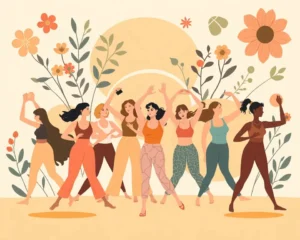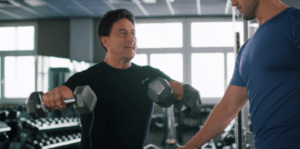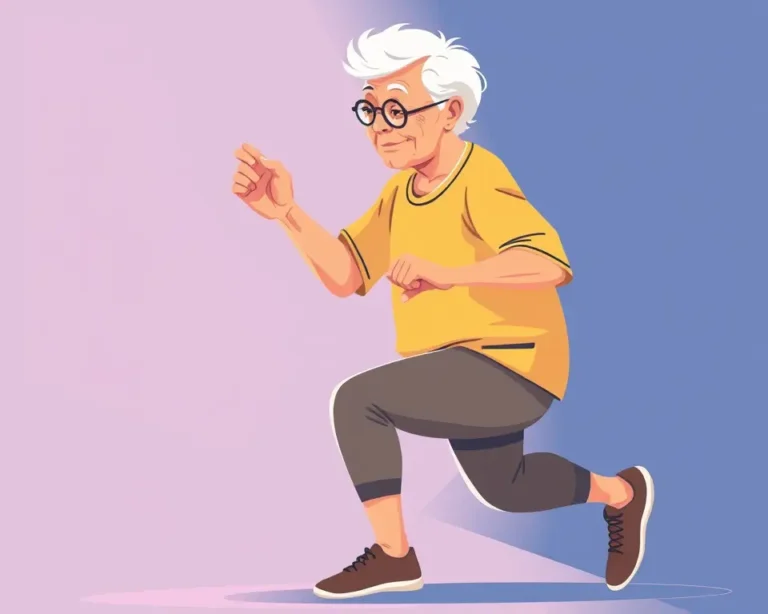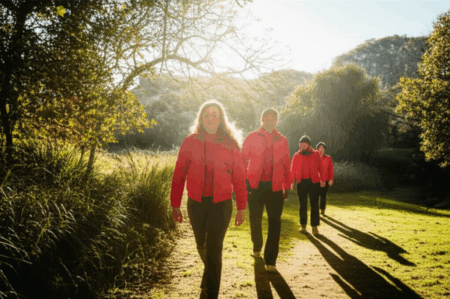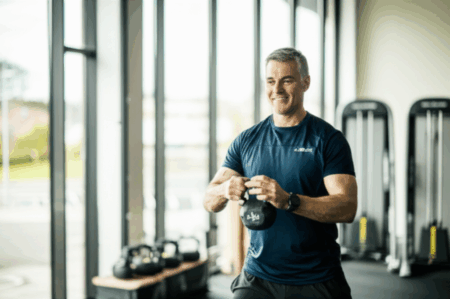Staying active after 60 is vital for maintaining independence, preventing disease, and boosting overall well-being. Forget about high-intensity workouts that can strain your joints; low-impact exercises are the perfect solution for seniors looking to stay fit and healthy. This guide explores the best low-impact exercises tailored for people over 60, offering a comprehensive approach to senior fitness.
Why Low-Impact Exercise Matters for Seniors
As we age, our bodies change. Bones can become less dense, muscles lose strength, and joints may stiffen. High-impact exercises like running or jumping can put excessive stress on these areas, leading to pain and injury. Low-impact exercises, on the other hand, provide a gentle yet effective way to stay active without the risk of overexertion.
Here’s why low-impact exercise is particularly beneficial for seniors:
- Joint Protection: Reduces stress on knees, hips, and ankles.
- Increased Mobility: Improves flexibility and range of motion.
- Enhanced Strength: Builds muscle strength to support daily activities.
- Better Balance: Improves stability and reduces the risk of falls.
- Cardiovascular Health: Boosts heart health and circulation.
- Improved Mood: Eases anxiety and depression, promoting overall well-being.
- Disease Prevention: Helps prevent chronic diseases like heart disease, diabetes, and osteoporosis.
Aim for at least 150 minutes a week of moderate aerobic activity, along with strength, balance, and flexibility exercises at least two days a week. It’s okay if you can’t reach this number right away; gradually work towards it.
Getting Started: Key Considerations
Before starting any new exercise program, it’s essential to consult with your doctor, especially if you haven’t been active for a while or have any underlying health conditions. A healthcare professional can provide personalized advice and help you tailor a routine that’s safe and effective for your specific needs.
Here are some key considerations before you begin:
- Consult Your Doctor: Discuss your exercise plans with your physician.
- Start Slowly: Begin with shorter sessions and gradually increase the duration and intensity.
- Listen to Your Body: Pay attention to any pain or discomfort and stop if needed.
- Wear Proper Gear: Use supportive shoes and comfortable clothing.
- Stay Hydrated: Drink plenty of water before, during, and after exercise.
- Warm-Up and Cool Down: Prepare your body for exercise with a warm-up and allow it to recover with a cool-down.
The Best Low-Impact Exercises for Seniors
1. Walking
Walking is one of the simplest and most effective exercises for seniors. It’s easy on the joints, strengthens leg and core muscles, and can be done almost anywhere without special equipment.
Benefits:
- Strengthens muscles.
- Lowers risk of heart disease, stroke, diabetes, and colon cancer.
- Improves cardiovascular health.
How to incorporate it:
- Frequency: Aim for at least 30 minutes of brisk walking five days a week.
- Location: Find a flat, safe area like a park or quiet street.
- Technique: Start with a gentle warm-up at a slow pace, then walk briskly for 20-30 minutes, and cool down by slowing your pace during the last five minutes.
- Tips:
- Find a moderate trail through a park.
- Listen to an audiobook or playlist for stimulation.
- Walk the perimeter of a familiar building.
- Consider joining a walking group for social engagement.
2. Swimming and Water Aerobics
Swimming and water aerobics are excellent full-body workouts that are gentle on the joints. The buoyancy of water supports the body, reducing stress on muscles and joints.
Benefits:
- Full-body workout.
- Improves cardiovascular health.
- Soothes muscles and joints.
- Increases strength, flexibility, and balance.
How to incorporate it:
- Swimming:
- Technique: Start with water walking to adjust to the water’s resistance, then try basic strokes like freestyle or sidestroke at a steady pace for 10-20 minutes.
- Water Aerobics:
- Exercises: Aqua jogging, arm curls, flutter kicking, leg lifts, and standing water push-ups.
3. Cycling
Cycling is a fantastic low-impact cardiovascular workout that strengthens the legs and improves coordination. It’s adaptable to individual fitness levels and health conditions.
Benefits:
- Improves aerobic capacity.
- Increases leg strength.
- Easy on the joints.
- Improves heart condition.
How to incorporate it:
- Options: Outdoor cycling or indoor stationary bike.
- Technique: Adjust the bike seat and handlebars for proper posture, warm up slowly to loosen muscles, gradually increase pace to a moderate level, and cool down by pedaling slowly for five minutes.
4. Chair Yoga
Chair yoga is a modified form of yoga that can be done while seated or using a chair for support. It’s a low-impact way to improve muscle strength, mobility, balance, and flexibility.
Benefits:
- Improves muscle strength, mobility, balance, and flexibility.
- Reduces stress on muscles, joints, and bones.
- Improves mental health, sleep quality, and overall well-being.
How to incorporate it:
- Exercises: Overhead stretch, seated cat stretch, seated cow stretch, seated mountain pose, and seated twist.
- Tips: Focus on slow, controlled movements and deep breathing.
5. Pilates
Pilates is a low-impact exercise that emphasizes breathing, alignment, concentration, and core strength. It can improve balance, develop core strength, and increase flexibility.
Benefits:
- Improves balance.
- Develops core strength.
- Increases flexibility.
How to incorporate it:
- Exercises: Foot slides, leg circles, mermaid movement, side circles, and step-ups.
- Equipment: Mats, Pilates balls, and other inflated accessories can be used.
6. Tai Chi
Tai Chi is a gentle, flowing exercise that improves balance, coordination, and flexibility. It involves a series of slow, graceful movements and is known for its stress-reducing benefits.
Benefits:
- Improves balance, coordination, and flexibility.
- Reduces stress.
- Can be adapted to suit individual fitness levels.
How to incorporate it:
- Technique: Focus on slow, controlled movements and deep breathing.
- Classes: Consider joining a Tai Chi class for guidance and social interaction.
7. Strength Training
Strength training is crucial for maintaining muscle mass and bone density as we age. It helps improve balance, stability, and stamina.
Benefits:
- Prevents bone loss.
- Relieves osteoarthritis pain.
- Helps prevent chronic disease.
- Boosts immunity.
- Improves mood.
How to incorporate it:
- Frequency: Aim for at least two days a week of muscle-strengthening activities.
- Exercises:
- Bodyweight exercises: Wall push-ups, calf raises, shoulder blade squeezes, chair squats, and smaller repeated movements.
- Weight training: Squats with weights, lunges with weights, dumbbell rows, overhead press, and calf raises.
- Tips:
- Start slowly with light weights or bodyweight exercises.
- Focus on proper form to target the right muscles and reduce the risk of injury.
- Gradually increase the weight, repetitions, or sets as you get stronger.
8. Flexibility Exercises
Flexibility exercises help maintain range of motion, reduce stiffness, and improve overall mobility.
Benefits:
- Maintains range of motion.
- Reduces stiffness.
- Improves overall mobility.
How to incorporate it:
- Exercises:
- Neck stretches: Gently tilt your head to the left, right, forward, and backward, holding each stretch for 15-30 seconds.
- Shoulder rolls: Roll your shoulders backward and forward in a slow, controlled motion.
- Ankle circles: Rotate your ankle in a circular motion, clockwise and counterclockwise.
- Calf stretch: Place your hands against a wall for stability. Bend one leg and step the other leg back at least a foot’s distance, keeping it straight.
- Doorway stretch: Stand in a doorway and brace your forearms against the doorframe.
9. Balance Exercises
Balance exercises are essential for preventing falls and maintaining stability.
Benefits:
- Reduces the risk of falls.
- Improves stability and coordination.
- Builds confidence.
How to incorporate it:
- Exercises:
- Single Limb Stance: Stand behind a steady chair, hold onto the back, and lift one foot off the floor. Hold for as long as possible, then switch feet.
- Heel-to-toe walk: Place one foot in front of the other, touching your heel to your toes, and walk in a straight line.
- Weight shifts: Shift your weight from one foot to the other.
- Back leg raises: Place your hands on a wall or the back of a chair and slowly lift one leg back and up as high as you can.
- Flamingo Stand: Stand with feet shoulder-width apart and touch your hands to a wall. Raise your right leg up to your hip as though marching. Lower it and do the same for the left.
Sample Weekly Workout Plan
Here’s a sample weekly workout plan that incorporates a variety of low-impact exercises:
- Monday: Walking (30 minutes).
- Tuesday: Chair Yoga (30 minutes).
- Wednesday: Swimming or Water Aerobics (30 minutes).
- Thursday: Strength Training (20-30 minutes).
- Friday: Tai Chi (30 minutes).
- Saturday: Rest or light stretching.
- Sunday: Cycling (30 minutes).
Tips for Staying Motivated
Staying motivated is key to making exercise a regular part of your life. Here are some tips to help you stay on track:
- Set Realistic Goals: Start with small, achievable goals and gradually increase the challenge.
- Find an Exercise Buddy: Exercising with a friend can provide motivation and support.
- Make it Enjoyable: Choose activities that you find fun and engaging.
- Track Your Progress: Keep a record of your workouts to see how far you’ve come.
- Reward Yourself: Celebrate your accomplishments with non-food rewards.
- Join a Class or Group: Participating in group fitness activities can provide social interaction and motivation.
Safety First
- Warm-up: Always start with a 5- to 10-minute warm-up of light cardio and gentle stretches.
- Cool-down: End each workout with a 5- to 10-minute cool-down of light cardio and stretches.
- Proper Form: Focus on maintaining proper form to avoid injuries.
- Listen to Your Body: Stop if you experience pain, dizziness, or shortness of breath.
- Stay Hydrated: Drink plenty of water before, during, and after exercise.
Low-impact exercises offer a safe and effective way for seniors to stay active, maintain their health, and enjoy a higher quality of life. By incorporating a variety of activities into your routine and listening to your body, you can create a fitness plan that works for you and helps you stay strong and independent for years to come.


